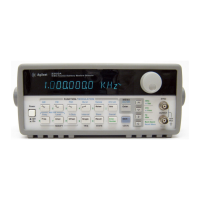DATA:DAC VOLATILE, {<binary block>|<value>, <value>, . . . }
Download binary integer values between -2047 and +2047 into volatile
memory. You can download between 8 and 16,000 points per waveform
in
IEEE-488.2 binary block format or as a list of values. The binary range
of values corresponds to the values available using internal 12-bit DAC
(Digital-to-Analog Converter) codes.
The values -2047 and +2047 correspond to the peak values of the
waveform. For example, if you have set the output amplitude to
10 Vpp, “-2047” corresponds to -5 volts and “+2047” corresponds to
+5 volts.
The maximum amplitude will be limited if the data points do not
span the full range of the output
DAC (Digital-to-Analog Converter).
For example, the built-in “
SINC” waveform does not use the full range
of values between
1 and therefore its maximum amplitude is
6.084 Vpp (into 50 ohms).
The DATA:DAC VOLATILE command overwrites the previous
waveform in
VOLATILE memory (no error is generated). Use the
DATA:COPY command to copy the waveform to non-volatile memory.
Up to four user-defined waveforms can be stored in non-volatile
memory. Use the DATA:DEL command to delete the waveform in
VOLATILE memory or any of the four user-defined waveforms in
non-volatile memory. Use the DATA:CAT? command to list all
waveforms currently stored in volatile and non-volatile memory
(and the built-in waveforms).
After downloading the waveform data to memory, use the FUNC:USER
command to choose the active waveform and the FUNC:SHAP USER
command to output it.
4
Chapter 4 Remote Interface Reference
Arbitrary Waveform Commands
179

